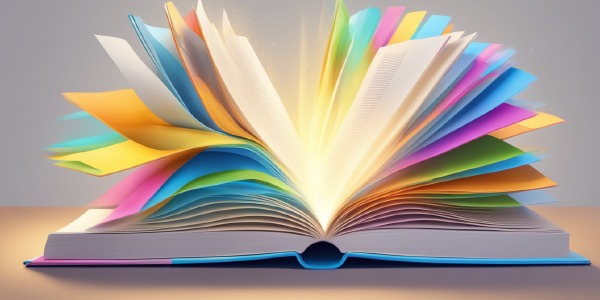E-books vs. Traditional Books: Comparing Learning Resources for the Modern Reader
The debate between e-books and traditional books has been ongoing as technology becomes increasingly integrated into our everyday lives.
E-books offer a new dimension of convenience and accessibility that challenges the long-standing dominance of physical books. They allow readers to carry entire libraries in their pockets, adjust font sizes and styles for better readability, and possess unique features such as built-in dictionaries and note-taking capabilities.
On the other hand, traditional books have a tactile appeal that e-books cannot replicate. The sensory experience of turning the pages, the smell of the paper, and the satisfaction of seeing progress through a physical stack of pages resonate with many readers.

The decision on whether e-books or traditional books are the better learning resource is not a simple one. It encompasses various factors, including personalization, the intended use of the resource, individual learning styles, and lifestyle considerations.
E-books could be considered more environmentally friendly, reduce the need for paper and ink, and are instantly accessible from anywhere with internet access.
Conversely, traditional books do not require power or an electronic device, making them more reliable in a low-tech situation. Both forms have their own set of advantages and drawbacks, from ease of use to potential health implications like eye strain from screen use, which must be weighed by each individual.
Key Takeaways
- E-books provide convenience and advanced features, yet lack the physical experience of traditional books.
- Factors such as environmental impact, personalization, and user experience influence the choice between e-books and traditional books.
- Both e-books and traditional books have unique benefits that cater to different preferences and situations.
Understanding E-Books

E-books, or electronic books, offer a digital alternative to traditional paper-based books, allowing you to read using various electronic devices. They have significantly impacted how you consume and engage with written content.
The Digital Shift in Reading
The transition to digital reading has been significant, with e-books now widely available across multiple platforms and devices.
You can easily purchase or access e-books through specific e-reader devices, smartphones, tablets, or computers. This shift has introduced a new level of convenience to reading, enabling you to carry entire libraries in your pocket.
Advantages of E-Books
Portability: E-books are highly portable, making it possible to carry multiple titles on one lightweight device, ideal for on-the-go reading.
- Convenience: With e-books, you have immediate access to a vast selection of titles at any time, without physical space limitations.
- Searchable Content: You can quickly search for specific information within an e-book, saving time in your research or study.
- Adjustable Text: Customize your reading experience by adjusting the text size and font to suit your comfort.
- Environmentally Friendly: E-books are more eco-friendly as they eliminate the need for paper and ink and reduce the carbon footprint associated with shipping physical books.
Cost-Effective: Often, e-books are cheaper than their physical counterparts due to lower production and distribution costs.
E-Books and Education
The incorporation of e-books into education has transformed the learning landscape.
E-books can support multimedia content, such as audio and video, enhancing the learning experience.
Interactive features like annotations, highlights, and note-taking can be synced across devices, providing a seamless experience for your studies.
Moreover, the availability of e-books can increase access to learning materials, particularly important for educational equity.
Exploring Traditional Books

In this section, you will discover the enduring charm of traditional books and understand how printed materials facilitate learning.
The Appeal of Print
Tactile Experience: When you grasp a printed book, the weight and texture of the paper contribute to a sensory experience. The act of physically turning each page adds a sense of progress that isn’t replicated with an e-book.
Library Atmosphere: Libraries, with shelves lined with ink and paper treasures, offer a serene ambiance that many readers find conducive to learning. The physical presence of books can be a source of inspiration and motivation.
Learning with Traditional Books
Engagement with Text: Traditional books often provide an undistracted reading environment. With no notifications to divert your attention, you absorb information more thoroughly.
Note-taking: Many readers find it easier to interact directly with a printed text, using highlighters and pens to annotate margins, which can enhance your comprehension and retention of material.
Carbon Footprint: It’s worth considering the environmental impact; the production of paper, ink, and the print process all contribute to a traditional book’s carbon footprint. However, printed textbooks can be reused across multiple generations of students, potentially reducing the overall environmental impact when compared to single-user digital devices.
Comparative Analysis

In exploring the effectiveness of e-books versus traditional books as learning resources, you’ll uncover the advantages and disadvantages they offer, the costs involved and the benefits they may yield.
Pros and Cons of E-Books vs. Traditional Books
E-Books:
Pros:
- Portability: You can carry hundreds of e-books on a single device, which is convenient for your mobility.
- Searchability: Quickly locate text within the e-book, enhancing your study efficiency.
- Adjustability: Customize font size and style to suit your visual preferences, potentially reducing eye strain.
Cons:
- Distractions: Devices hosting e-books can present numerous distractions, possibly affecting your focus.
- Battery Life: Dependence on electronic devices means you need regular access to power for charging.
- Tactile Experience: Lack of physical interaction can diminish the traditional reading experience and may impact memory retention for some learning styles.
Traditional Books:
Pros:
- No Battery Required: Continue reading without concern for electronic access or power.
- Note-Taking: Easily write notes in the margins, which can reinforce learning and comprehension.
- Sensory Experience: The physical aspect of handling a book can enhance your memory retention through tactile engagement.
Cons:
- Weight and Space: Carrying multiple books can be cumbersome and physically demanding.
- Inflexibility: You can’t change the print size, which may be problematic for visual comfort.
- Replacement Cost: If lost or damaged, the replacement cost of physical books can be high.
Cost-Benefit Analysis
When analyzing costs, you’ll find that e-books typically cost less than their printed counterparts, leading to potential savings for you, especially if you source them from a library or educational institution.
Initial investment in an e-reader may seem high, but over time the cost per book decreases, making e-books a cost-effective option in the long term.
Traditional books, on the other hand, might offer a higher resale value, providing you with an opportunity to recoup some of your expenses. However, the cost of physically producing and distributing traditional books is normally reflected in their pricing.
Learning Outcomes and Student Experience
The learning outcomes and experience can vary based on whether you’re using e-books or traditional books.
With e-books, you can take advantage of integrated dictionaries and interactive content that can contribute to a more robust learning experience. However, the screen time associated with e-books can lead to eye strain and impact your focus over extended periods.
Traditional books have been shown in some studies to offer better reading comprehension and memory retention for certain students, possibly due to fewer distractions and a more focused reading environment.
Each type of book complements different learning styles and serves varying educational needs. It’s important to consider your own preferences when deciding which type serves as a better resource for your personal learning goals.
Personalization and Accessibility

E-books offer a level of personalization and accessibility that traditional books can’t match, catering to your unique reading needs and preferences with various tools and features.
Customization Options
E-books provide a range of customization options that allow you to tailor your reading experience according to your personal preferences and learning styles. You have the flexibility to modify text size and font style, which is particularly beneficial if you have visual impairments or simply want a comfortable reading experience.
For instance, you can adjust:
- Font style: Choose from a variety of fonts that suit your reading comfort.
- Text size: Increase or decrease the text size to reduce eye strain.
Some e-readers and e-book apps also include features like adjustable background color and brightness, as well as note-taking and highlighting tools. These can be particularly effective if you want to engage with the content by making annotations or if you need to adjust the display for reading in different lighting conditions.
Accessibility for All
Technology has significantly enhanced accessibility for individuals with disabilities, and e-books harness this to provide features that make reading more accessible.
Among these features are:
- Text-to-speech: Converts text into spoken words, useful for users with visual impairments or learning disabilities.
- Screen readers: Complements text-to-speech for a fuller auditory reading experience.
- Audio enhancements: Some e-books come with additional audio support to aid comprehension.
These accessibility features ensure that regardless of your abilities or challenges, you can enjoy reading and learning from e-books.
Your learning experience is no longer limited by physical barriers, as e-books can be accessed anytime and anywhere with the right technology.
Environmental and Lifestyle Considerations

Choosing between e-books and traditional books isn’t just about reading preferences, it also touches on the environmental effects and how they mesh with modern lifestyles.
Environmental Impact
E-books offer an environment-friendly alternative to traditional books by eliminating the need for paper, which can result in less deforestation and a reduction in resource use.
You won’t find yourself having to recycle or dispose of physical copies, which helps to minimize waste.
On the flip side, remember that e-readers require minerals and fossil fuels for manufacturing and need to be charged, which still has an environmental footprint.
Reading in the Digital Age
Digital age technologies have made it possible for you to carry thousands of books in the palm of your hand.
E-books allow for interactive learning experiences with in-text features like immediate dictionary access, making your reading experience more dynamic.
However, the screens can strain your eyes and contribute to longer screen time, which might be a consideration for your eye health and overall well-being.
Lifestyle and Reading Habits
Your lifestyle and reading habits are crucial when choosing the best learning resource.
If you’re always on the go, e-books can be more practical as they’re portable and easily accessible on various devices.
In contrast, physical books offer a tangible experience that many readers find satisfying.
Your reading habits may dictate the preference for the flexibility of an e-book or the sensory experience of a traditional book.
The Future of Reading

As you look towards how you’ll be absorbing information in the years to come, it’s clear that emerging technologies and the evolution of learning resources are fundamentally reshaping the reading experience.
Emerging Technologies
Imagine reading on screens that feel like paper—e-ink technology and electronic paper are making strides in mimicking the comfort of reading a traditional book.
Your e-textbooks might soon be as easy on the eyes as the printed page, but far more capable.
With the incorporation of interactive features like hyperlinks and animations, the text could leap off the “page” in a much more literal sense.
Interactive tables and lists make information more digestible, like so:
- Videos embedded within digital pages
- Animations to illustrate complex concepts
- Hyperlinks to instantly bring you additional resources
And if you’re reading on a PC or an iPad, you can expect software that supports a higher level of engagement with the material, thanks to these interactive elements.
The Evolution of Learning Resources
Your future classroom might not include a stack of textbooks, but rather a collection of digital resources carefully curated by educators.
Digital textbooks are evolving to be more than mere electronic replicas of printed materials.
Publishers are now creating sophisticated e-textbooks that seamlessly integrate with classroom technologies, becoming an active participant in the learning process.
Here’s a quick look at how e-textbooks might evolve:
- Personalized learning tracks based on your progress
- Instant assessments that help gauge your understanding in real-time
With these tools at your disposal, the way you learn could become more personalized and efficient.
Market and Availability

When you consider e-books and traditional books, you find that each has distinct dynamics in terms of how they’re published, distributed, and accessed. The resell value and market for used copies also widely differ.
Publishing and Distribution
E-books: The process is significantly faster for e-books, allowing for immediate distribution upon release. You don’t have to wait for printing, and as a result, an e-book can go from final edit to available on your e-reader in virtually no time.
Traditional Books: These require physical production, which can take weeks or months. Distribution to bookstores also adds time and cost. However, for many readers, the anticipation of a new hardcover release is part of the charm.
Availability and Access
E-books: You can access an entire library online.
E-readers like Kindle and tablets provide a platform where you can store thousands of books in one place, often at a more affordable price compared to their physical counterparts.
- Libraries: Many now offer e-book lending, similar to traditional book lending.
- Price: Generally lower for e-books, and frequent online sales make them even more affordable.
Traditional Books: Availability can depend on stock at bookstores or libraries. Some books go out of print, which can limit access.
- Libraries: Still a vital source for free access to physical books.
- College Textbooks: Often available in both formats, though e-textbooks can offer savings and convenience.
Second-Hand Market and Resell Value
E-books: There’s no resale market, as licenses typically don’t allow for transfer. Once you buy an e-book, it’s yours indefinitely without the option to resell.
Traditional Books: Hardcovers and other physical books can be resold or donated, and second-hand bookstores are a testament to the vibrant market for used books. Resell value can fluctuate based on demand and condition.
- College Textbooks: Reselling textbooks after a course is completed is common practice, often recouping some of the original expenditure.
User Experience and Health Concerns

When choosing between e-books and traditional books, you should consider how the mode of reading affects your learning and health. Screen-based reading and the physical nature of paper books offer different user experiences and have specific health implications you must be aware of.
Reading on Screens vs. Paper
Reading from screens, whether it’s an e-ink device like Kindle or an LCD tablet, presents a different experience than reading from the pages of a textbook.
While e-books on a single device may offer convenience and portability, the tactile sensation and visual presentation of text on paper may help in better retention of information.
You also have the ability to interact physically with paper by highlighting text and making margin notes, which can aid in your learning process.
Moreover, staring at electronic paper has shown less visual fatigue than traditional backlit screens because e-ink mimics the reflectiveness and contrast of physical paper.
This can be an important consideration if you spend long hours reading for your studies.
Health Concerns: Eye Strain and Blue Light Exposure
Prolonged exposure to screens, especially those that emit blue light, can contribute to eye strain.
If you’re reading on a standard electronic device, you’re exposed to this light, which can disrupt your sleep cycle and contribute to digital eye strain. Here’s a brief list of concerns and tips:
Eye Strain:
- Symptoms: Sore, tired, burning, or itching eyes
- Prevention: Follow the 20-20-20 rule; every 20 minutes, look at something 20 feet away for at least 20 seconds.
Blue Light Exposure:
- Risks: Can interfere with your circadian rhythm, leading to poor sleep patterns.
- Management: Use blue light filters or glasses when using devices.
Conclusion

When considering e-books and traditional books as learning resources, your choice hinges on your needs and preferences.
E-books offer unparalleled accessibility, letting you carry a whole library in your pocket. Immediate access to a wide array of titles and built-in features such as search functions and resizable text provides customized reading experiences. For students and educators alike, the utility of these features in a classroom setting can support diverse learning styles.
In contrast, traditional books have a tactile feel that many find irreplaceable. They do not require batteries or electronic devices, which is a significant pro for sustainability and for those who cherish unplugging from the digital world. The physical nature of a book can also make for a more immersive educational experience for some, fostering concentration.
Both formats have their pros and cons, and your educational strategy might benefit from a combination of both.
While e-books seem to be paving the way for the future, the sentimentality and familiarity of traditional books have reserved their place in both personal and educational settings. It’s essential to cater to the needs of all students, and providing options to accommodate different preferences can lead to more effective learning outcomes.
Choosing the right learning resource is a personal decision, and yours might involve balancing the practicality of e-books with the sensory experience of traditional books. Whatever your decision, it should align with your educational goals and the way you or your students learn best.




